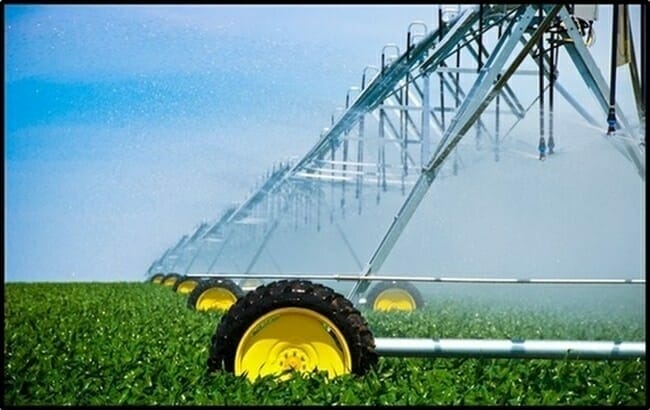Investor Alert: Buying shares in a “vertically integrated hemp company” means that you are now in the farming business, subject to the whims of Mother Nature.
Recent events in Nevada, Hawaii and Oregon, remind us what a bitch she can be.
Hemp – and its expensive derivative CBD – has moved from health fad, to accepted medicine, to mainstream usage in less than five years.
In fact, hemp is older than Larry King, older than coffee, older than democracy.
Archeologists in Turkey have found hemp fabric dating back to 8,000 BC.
On September 25, 2019 Crop Infrastructure (CROP.C) announced that “eight of 10 of the company’s hemp pivots in Nevada have been severely affected by invasive weeds.”
Crop uses Pivot irrigation – galvanized steel pipe with sprinklers positioned along their length and mounted on wheeled towers. The flat Nevada landscape is ideal for this type of irrigation.
Crop’s Nevada cultivation target was to produce 10-20% CBD genetic hemp-CBD which will be extracted and isolated to produce a minimum 99.5% pure CBD isolate.
“In several northern pivots, a herd of antelope also caused significant damage,” stated Crop, “The operating partner had employed a farming method of planting cover crops to keep the weeds away, however, it was not effective with the exception of all but two pivots.”
Crop’s biz model is to loan capital to purchase real estate, which is then leased to the producer/processor. Crop receives fees until the deployed capital is returned – at which point Crop takes a 30-49% interest in the operation and will receive dividends until the CEO’s grandchildren have their own grandchildren.
The business model has been weakened by the loosening of banking regulations in the US. – giving hemp farmers access to more traditional sources of capital funding.
According the press release, Crop is “reviewing the causes of the operational failure.”
By mid-morning Crop is down 27% to .04 on 4 million shares traded. The stock is now down 95% from its 12-month high of .57.
Crop has decided to release the leased 850 acres of lost pivoted crops and focus on the remaining pivots covering 500 acres.
Nevada is not the only trouble spot for hemp farmers.
In August, 2019 “more than 50% of Hawaii’s 2019 research hemp crop had to be destroyed because of elevated THC levels,” reported the Hemp Industry Daily (HID), “a problem that state agriculture officials attribute to a lack of cultivars suited to a tropical climate”.
Eighteen crops were destroyed and another four hemp crops exceeded legal THC limits but were granted waivers because the THC was close to the legal limit of 0.3%, the Honolulu Star-Advertiser reported.
A cannabis plant is legally classified as hemp rather than marijuana if it contains 0.3% or less THC.
“It is really hard to grow a plant that is 0.3 % or below,” stated Shelley Chow of the Hawaii Department of Agriculture, “in Hawaii we have a unique climate and photoperiod, compared to other states.
“Genetics which work in other states don’t necessarily work the same here,” stated Chow, “We are trying to figure all this out, and we haven’t figured it out yet.”
On August 9, 2019 a hailstorm in Central Oregon damaged or destroyed 400-500 acres of hemp, causing an estimated $25 million in losses.
“Hemp farmers in Central Oregon were faced with a situation no grower wants to see,” reported HID, “when severe thunderstorms in the area dumped golf ball-sized hail onto their fields.
“Most of the hemp acreage in Central Oregon is dedicated to CBD production and planted with feminized seed, which averages $1 per seed.
“Friday evening, we were just about to leave the farm for the day and we saw the hailstorm rolling in,” recalled Wesley Ray, a local hemp farmer, “so we backed our pickup under the barn and waited.”
“We sat there for 12 minutes and just watched almost every leaf on the majority of the plants be decimated to fully laying on the ground. And then it was just heart-wrenching to walk out there.”
Ray applied a soluble seaweed with a nitrogen-phosphorus-potassium blend at 8 gallons per acre, in the hope of reviving his damaged crop.
Antelopes, weeds, high-THC and hailstorms are not the only risks facing hemp famers.
“During this CBD-dominant market, cross-pollination is a risk,” states Leafly, “Large outdoor hemp fields, even grown with feminized seeds, will still have a few rogue male plants. Grown at scale, it’s impossible to guarantee 100% female germination.
“Most lawmakers are ignorant of the hemp industry,” states Rye Matthews, Chief Technology Officer at Northeast Hemp Commodities. “States don’t seem concerned. They’re letting farmers do as they wish and expecting that the market and private disputes will work themselves out.”
“High CBD prices have caused a bit of a “gold rush” into the industry, drawing in some new producers who have no agricultural background”, confirmed Katie Russell, manager and research scientist for Colorado State University’s Southwestern Colorado Research Center in Yellow Jacket.
“We have been humbled by the realities of commercial scale farming with hard lessons learned,” stated Crop’s CEO Michael Yorke, “but we are readying our teams to complete the harvesting of the remaining hemp in Nevada.”
Full Disclosure: Crop Infrastructure was an Equity Guru marketing client. We have no current financial relationship with any company mentioned in this article.





